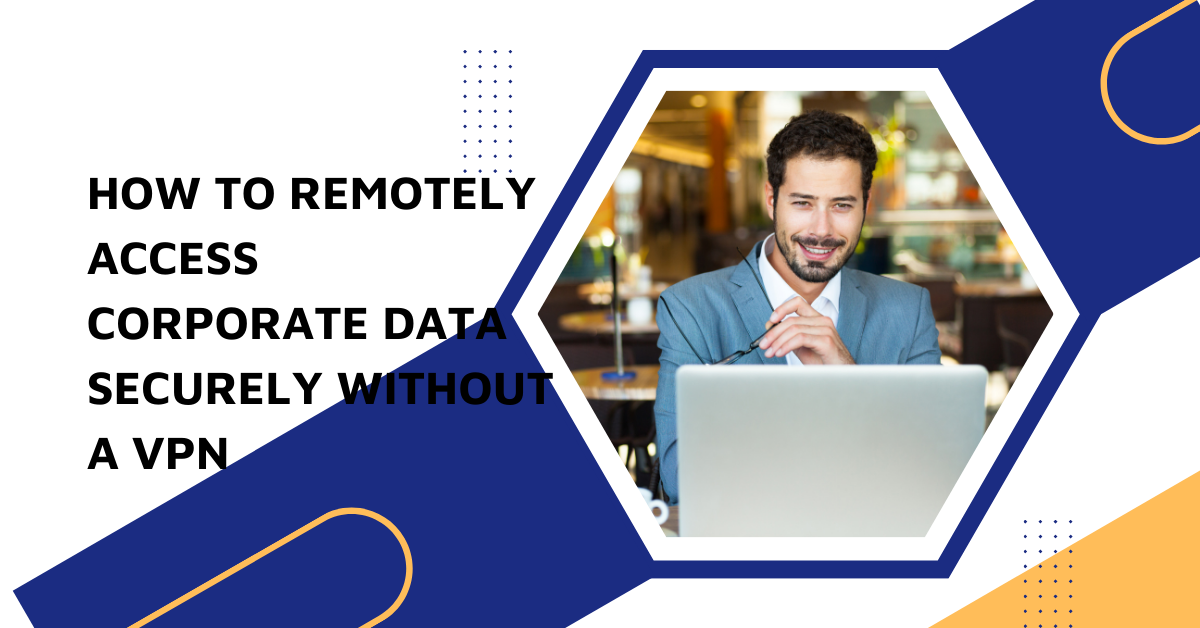This post will show how to remotely access corporate data securely without a VPN.
VPNs are one of the most common tools used for remote access. However, they are not the only solution for securely accessing corporate data. The VPN protocol is outdated and can be broken by hackers. And using a VPN is no longer necessary because there are other ways to do so securely.
Remote access to your company’s data is necessary for today’s modern business. With the rise of cloud computing and the expansion of wireless and cellular networks, many organizations now store and process data remotely.
This has changed the way we think about enterprise security. The advent of cloud computing has put more pressure on IT departments to secure data stored off-premises.
Here are some ways to access corporate data remotely without using a VPN.
Table of Contents
How To Remotely Access Corporate Data Securely Without A VPN
Remote Access Server
Remote access servers are designed to secure the connection between your remote employees and the corporate data center. The most significant benefit of this solution is that the communication between the employee and the server is always encrypted. This reduces the bandwidth employees need to download or upload, making it ideal for mobile workers.
Remote access servers differ from VPNs because the server is not inside the company’s premises. It is situated in the cloud, often in a separate location from the building. Typically, a remote access server is a service offered by a third-party cloud provider.
This approach is one of the best ways to secure remote access without a VPN, since the server never touches a corporate network and is, therefore, safer from attack.
Web Proxy Applications
As an alternative to VPNs, web proxy applications allow companies to mask the locations of their data. The data can then be accessed from any device, including a mobile phone, an IP-enabled TV, or even a personal computer.
A web proxy application works as an encryption layer on top of an internet connection. This acts as a bridge between the user’s data and the server that hosts the data. In other words, the user’s data never connects directly to the server. Instead, it is routed through the web proxy.
The advantage of this solution is that the data doesn’t have to go through the VPN to be accessed. This allows the employee to access and edit corporate data securely from anywhere, without logging into a corporate domain.
Identity and Access Management (IAM)
An IAM solution creates a secure access policy, which will be applied to each employee. This way, you can configure access rules for specific employees or locations. Thus, the access policy will never get confused. For example, you can set a time limit for an employee’s access to a particular project or repository.
There is no specific software billed as an IAM, instead it is a suite of tools that enables a company to configure the access policies. The challenge with this method is that the vendor will charge for each employee’s access policy. This can be a barrier to most enterprises’ adoption.
READ ALSO: CCIE Data Center Training
SSH or Secure Shell (SSH)
An SSH connection works similarly to remote access servers. However, the main difference is that an SSH connection is a peer-to-peer system. It makes it impossible for a single user to access the data fully. It’s like the internet, where only a single IP address is allotted per user.
This method is ideal for larger enterprises. Many software vendors are offering this solution. Generally, it is meant to be used by enterprise IT departments, although small businesses can also benefit from it.
Securely Reaching the Office: Remote Data Access Beyond VPNs (FAQs)
While VPNs (Virtual Private Networks) are a popular solution for remote access, they aren’t the only option. Here are some FAQs to explore secure alternatives for accessing corporate data remotely:
Can I access corporate data securely without a VPN?
Yes, there are alternative methods for secure remote access, but they might come with different functionalities and security considerations compared to VPNs. Here are some options:
- Zero Trust Network Access (ZTNA): ZTNA grants access based on user identity and device verification, providing a more granular security approach than traditional VPNs.
- Cloud-based applications: Accessing corporate data through secure cloud-based applications eliminates the need for a VPN connection entirely. Data resides in the cloud, and the provider’s security measures control access.
- Remote Desktop Protocol (RDP) with enhanced security: RDP allows remote access to specific desktops within the corporate network. However, RDP should be coupled with multi-factor authentication and strong password policies for enhanced security.
What factors should I consider when choosing an alternative to VPN?
Here are some key considerations:
- Security features: Ensure the chosen method employs robust encryption and authentication protocols to protect data in transit and at rest.
- Ease of use: Consider how user-friendly the solution is for both employees and IT administrators.
- Scalability: If your organization has a growing remote workforce, choose a scale solution to accommodate future needs.
- Compliance requirements: Certain industries have data security regulations that might influence the choice of remote access method.
Is remote desktop access (like RDP) secure without a VPN?
RDP itself doesn’t provide the same level of security as a VPN. To enhance RDP security, consider:
- Multi-factor authentication: Adding an extra layer of verification beyond just a password.
- Strong password policies: Enforce complex password requirements and regular password changes.
- Limiting access: Restrict RDP access only to authorized devices and users.
- Network segmentation: Segregate the RDP environment from the rest of the corporate network for added protection.
Are there any security risks to consider when avoiding VPNs?
While alternatives offer advantages, they might also introduce different security risks:
- Complexity: Managing and securing some alternatives can be more complex than using a VPN.
- Vendor dependence: Cloud-based solutions rely on the security practices of the cloud provider.
- Potential compatibility issues: Some solutions might not work seamlessly with all devices or operating systems.
Conclusion
In conclusion, while VPNs are a standard solution, other methods can provide secure remote access to corporate data.
Carefully consider your organization’s specific needs, security posture, and technical expertise before choosing the most suitable alternative
INTERESTING POSTS
- How to Securely Send Sensitive Information Over the Internet
- How IT Professionals Can Monitor Remote Employees’ PCs Without Violating Privacy Laws
- 4 Essential Cybersecurity Tips To Implement When Working Remotely
- Compliance In The Cloud: Why IAM Is Critical
- Passwork Is Available With A 50% Discount As Part Of Black Friday
- 4 Ways Ransomware Can Infect A System
About the Author:
Daniel Segun is the Founder and CEO of SecureBlitz Cybersecurity Media, with a background in Computer Science and Digital Marketing. When not writing, he's probably busy designing graphics or developing websites.








